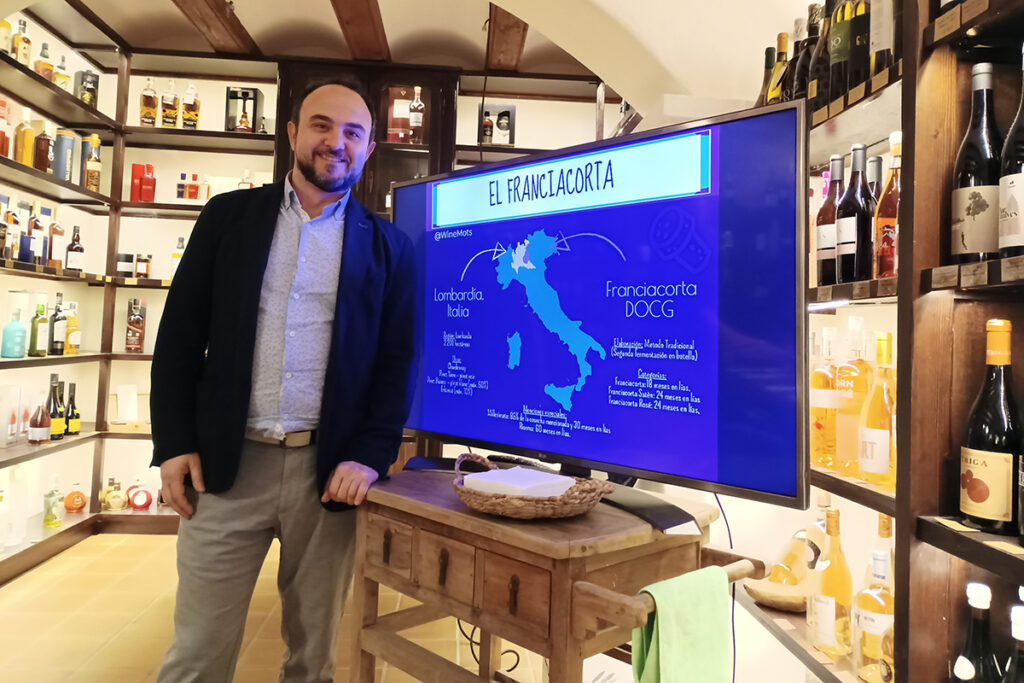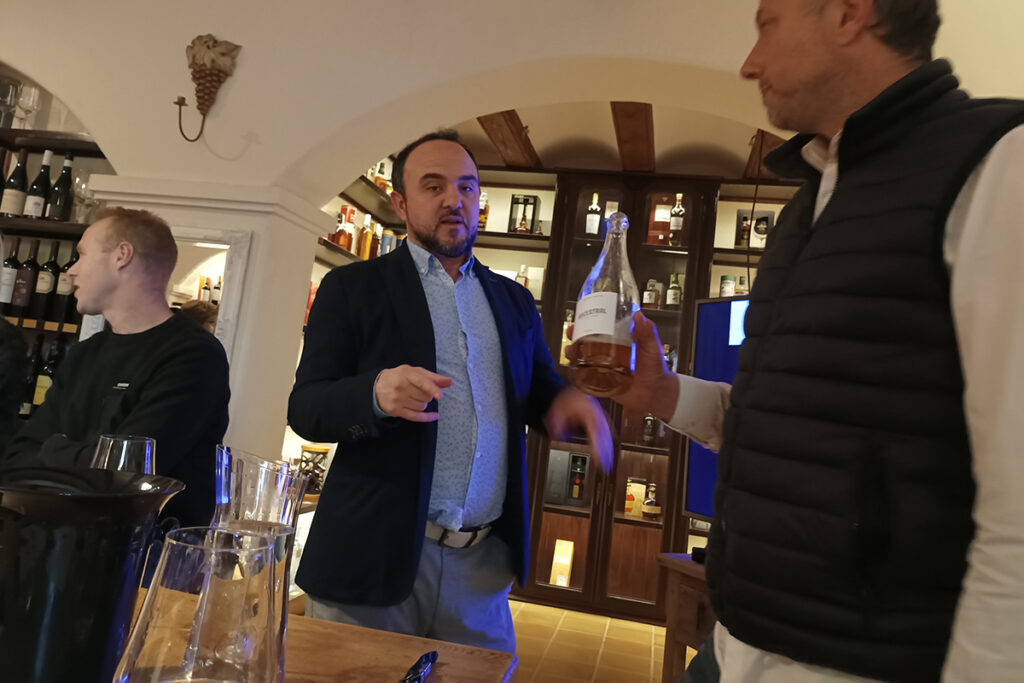20 febrero, 2025

Colin Harkness
In my, largely mis-spent youth, I was aware of Sparkling Wine, which was another way of saying Champagne – as far as I knew, the only type of alcoholic fizz. I won’t re-iterate words I’ve said before, except to say that this is largely because of the superb PR job the Champagne officials have done for well over 100 years now.
Add this to the fact that we young lads, my brother and I, grew up in a Methodist household where there was no alcohol, ever, and you can see why I laboured under a misapprehension for so long. Champagne, of course is, as many will know, not the only type of Sparkling Wine. Neither is its method of production restricted to just the wines from that hallowed French ground, the Champagne area.
There are many other sparkling wines throughout the world which are made by using the same method, now called the ‘Traditional Method’. Plus, there are many other sparklers made by different methods. It’s a fascinating topic. Enter Bouquet Xaló – and our answer to the question posed as the title of this month’s article!

The small, inland town of Jalón is very much a wine orientated place, as indeed regular readers of this column will know. There are a few wine shops in the area catering for the locals as well as visitors, of which there are many, as Jalón (Xaló in Valenciano) really does a good job of welcoming tourists. However, in October of last year, Nuria (Spanish) and Robert (Dutch) decided to open a, shall we say, ’higher-end’ wine shop – Boutique Xaló.
Apart from selling local wines too, they also have many references from regional, national and international wineries, selling inexpensive entry level wines to more elite examples. Tasty, jars of wine-apt, extremely edible produce is available, top quality olive oils, nuts etc. Plus, Boutique Xaló offers occasional tastings. We’ve attended a few to date, the last of which was a tasting of eight different sparkling wines, examples of all the different ways of making them – well, they left out, for obvious reasons, the far lesser method (carbonation) by which, Coke, for example, is made!
We were therefore in for a rare opportunity to taste the different methods against each other all on the same night, plus a tasty morsel to pair with each, from the countries whence the wines came! Readers may well have heard of Prosecco (?!), but maybe less likely, though from the same country, Franciacorta. Made by different methods and wholly different in every way. We’ve probably all heard of Pet Nat, perhaps less likely, the Ancestral method of production? See what I mean – fascinating. But, that wasn’t all.
The tasting was to be led by the esteemed Sommelier, Jorge Femenia, a friend of ours and a great amigo de vinos!
A full table assembled, in fact mostly Dutch, for the first of the two sessions at least, and, after introductions, Jorge gave us a brief description of the different methods of production. He started with the most modern, ending with the oldest – and we are talking here of centuries! However, you may be in for a surprise?
‘Newest’ method is the Charmat method (named after its inventor), sometimes, and certainly less attractively, called the ‘Tank Method’. This is the method by which the aforementioned Prosecco is made. As the second of its two names suggests this is where a base wine, made in a very often huge stainless-steel tank, undergoes a second fermentation in the same receptacle, provoked by the addition of some extra yeast and sugar. The resulting bubbles from the CO2 produced remain within the wine which rests in the tank for a short time before bottling.
The next method (the surprise?) is that which we’ve already mentioned, the Traditional method, which makes: Champagne, Cava, Italy’s Franciacorta, South Africa’s Cap Classique, France’s Crémant, Spain’s Corpinnat and a host of other sparklers throughout the globe. Again, this begins with a still wine already made but being poured into a bottle, not a tank. This still wine is drinkable, but not usually very pleasant as it’s often made from grapes picked slightly too early, to retain higher acidity. The bottles are, of course, nowadays instantly recognisable. They are specially made to withstand the extra pressure that is about to be created and retained in the bottle – a British invention, in fact, without which we may not ever have had Champagne et al?!
The second fermentation, referred to above, now takes place in the bottle in which the wine will remain until opened to drink. This method is generally thought of as the best way of making sparkling wine. It preserves the bubbles, the sparkle, for longer and because of the time the now sparkling wine remains in the bottle accompanied by its lees (the dead yeast cells) which add extra aroma and flavour nuances as well as greater depth and complexity.
Many wines made by this method, though depending also on the grape varieties from which they are made, can age in bottle for several years. I’ve tasted and thoroughly enjoyed Cava, for example, that has been resting on its lees for over five years.
The next method, the oldest, in fact first experienced in the 16th century, was explained with typical passion by Jorge. The Ancestral method is therefore one hundred years or so older than the famed Dom Perignon’s Champagne – another of the sparklers I’ve greatly enjoyed, the more so because I didn’t have to pay for it, on each occasion too! Bet you’d like my job, huh?!
I say ‘experienced’ above because it was more of a discovery than an intention to make a wine fizzy, a chance coincidence that was to change the face of a lot of winemaking for the centuries that followed. There is no record, as far as I’m aware, like there is regarding our no doubt often tiddly monk friend, of whom it was who first noticed the phenomenon, but sometimes during colder spells in Europe, wine which was being, perhaps after the last few days of the year’s harvest, the fermentation simply stopped, mid process.
Come Spring the following year the frustrated winemaker noticed that fermentation had somehow restarted. We know now of course that this was because of the drop and subsequent rise in temperature – fermentation will not occur with insufficient heat. Probably during the interim period, perhaps because wine supplies were running low, or, more romantically, perhaps to celebrate Christmas, our vigneron (I’m going to give it to the French here, after all the great Dom was French!) must have tried some of the wine that had stopped fermenting. He noticed that it was petillant, interesting, non, but perhaps a little disappointed that it was less alcoholic – be fair, times were hard!
Sparkling Wine born, made by the Ancestral method aka the Pet Nat, or Método Rural methods.
Of course, technology moves on – nowadays this style of wine is made by deliberately interrupting the fermentation process, bottling the wine and then allowing it to start again. Affix a metal cap just like that on a beer bottle, because of the increased pressure, and bingo, you have lightly sparkling wine.
So, the processes explained, questions asked and answered – what of the wines we tasted?
First up was L’Enclos 2023 made with Malvasia de Sitges grapes – a Pet Nat wine. For me, this was number seven on my list, though placed higher by my wife. The next was a rosé, same method, though termed Ancestral on the label. Ancestral Sumoll Rosat 2022 was a very pleasant surprise for me, not normally a fan of Ancestral wines, preferring by a distance the Trad. Method. However, this had more body than the first, more presence and a nice foil for the smoked salmon tapa pairing. Sumoll is the grape variety, black and most often used in red wine blends in Cataluña.
We then moved to Italy – for the current world’s best selling sparkling wine, you guessed it, Prosecco. For an impartial wine critic, I’m far too voluble about my dislike of Prosecco. Fact is I’ve never tasted one that I like – they’re generally too sweet for my palate, despite being labelled Brut, and they die so quickly in the mouth. However, as always, I tasted Valdobbladene Prosecco Superiore Brut professionally, without bias and found it to be – number eight of eight! I’m sure Prosecco lovers will like this wine though.
Impartiality is also important when expecting a certain wine to be of a high quality. So, I tasted L’O de L’Origan Cava Brut Nature, professionally and found it to be a quality wine, though not actually up there with other favourites in the Cava world. It has had four years on its lees, made with a blend of different varieties, and has the disgorgement date clearly displayed on the back label (an important point when buying traditional method sparklers) – all good things, but it wasn’t really one for me.
Next, we had a Corpinnat wine – what, I hear you ask? Well, this article is becoming far too long to explain all here, but briefly, the Corpinnat label is one that can be trusted implicitly. A long story, but several top-class cava producers decided to abandon the DO Cava, for a number of reasons, group together and make their version of cava, but with more stringent rules resulting, always in my view, in high quality Spanish Sparkling wine – when you see it, don’t shy away, buy it! Bufadors Les Voranes Brut Nature 2020 is a good example.
Oh dear, space has finally run out – the final three wines were high quality: a Sekt (German Fizz); a Franciacorta; and finally, a Champagne. My favourite of the whole excellent tasting? The latter! Yes, the Champagne oozed class and complexity, whilst retaining its freshness and proved that yes, Champagne is still top quality, but in my view, though not in Jorge’s, there are equals in the world of Sparkling Wine.
I hope the above is helpful and as informative as was this excellent Bouquet Xaló event.
Se advierte al usuario del uso de cookies propias y de terceros de personalización y de análisis al navegar por esta página web para mejorar nuestros servicios y recopilar información estrictamente estadística de la navegación en nuestro sitio web.
0 comentarios en